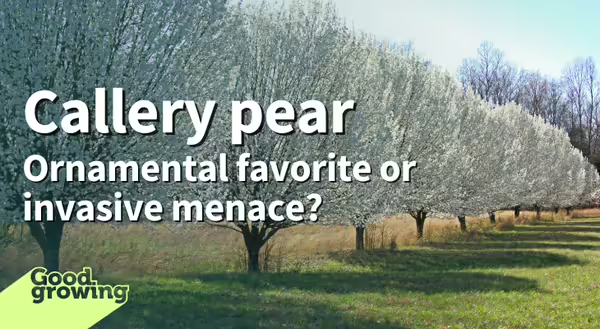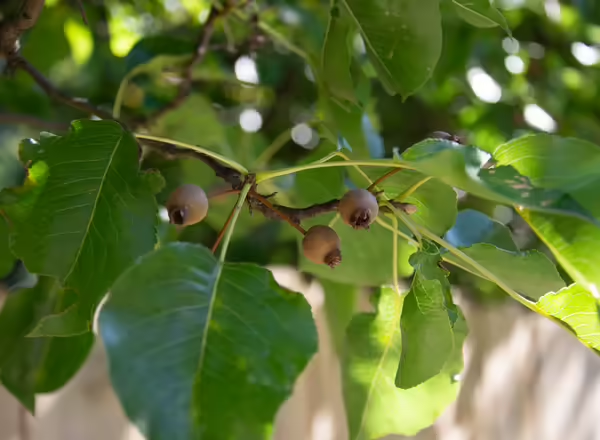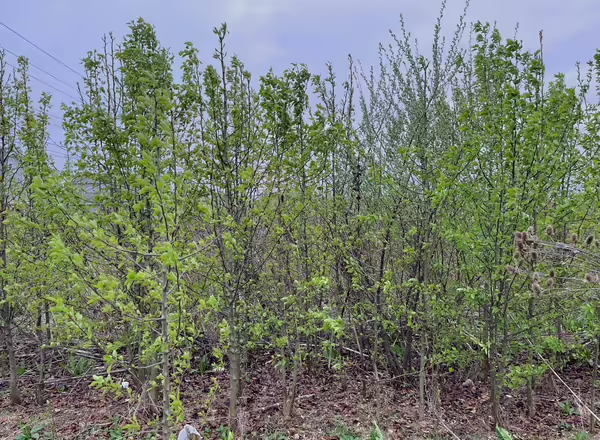
Callery pear (Pyrus calleryana), better known as ‘Bradford’ pear, has been blooming across Illinois. Over the years, it has been a popular tree to plant, especially in residential areas. Trees will reach 30 to 40 feet in height and produce numerous white flowers in the spring. Trees also have attractive glossy leaves that will turn a brilliant red-orange in the fall. However, they are also becoming increasingly problematic across Illinois and the United States.
How did Callery Pear get here?
Callery pear has been imported to the U.S. multiple times. It was originally imported from Asia in 1909 to the Arnold Arboretum (Harvard University) and again in 1916 by the U.S. Department of Agriculture for the development of fire blight resistance in the common pear (Pyrus communis), which was a serious problem in the commercial pear industry at that time.
Callery pear was used as a rootstock for edible pears before gaining interest as an ornamental plant. In the 1950s, the ornamental value and hardiness of Callery pears were recognized, leading to the development of several cultivars, including the most well-known ‘Bradford’. By the 1980s, Bradford pear had become the second most popular tree in the U.S.
It has been widely planted due to its quick growth, adaptability to a wide range of soils, and pollution and drought tolerance. The trees also have a symmetrical to round shape that many people find desirable in addition to their abundant spring floral display.
The problem(s) with Callery pear
Unfortunately, Callery pear has several negatives. They have narrow branch angles, and this, along with their rapid growth, makes them rather weak. Trees often split and break apart during storms and frequently don’t last longer than 20 years before they begin to split apart. Additionally, while the floral display may be impressive, the smell is not. The fragrance of Callery pears has been described as smelling like dead fish, vomit, urine, and other undesirable things.
When ‘Bradford’ pears were originally introduced to the landscape trade, they were touted as having sterile fruit. This is because they are self-incompatible, meaning they require cross-pollination from another cultivar to produce seeds. Since most of the Callery pear trees that were originally planted were ‘Bradford,’ there was very little pollination occurring (unless they were planted near another cultivar).
However, new cultivars have been introduced, such as ‘Cleveland Select,’ ‘Aristocrat,’ and ‘Redspire.’ The introduction of these new cultivars meant greater chances for cross-pollination and, therefore, seed production.
Now that several cultivars are being grown in landscapes and trees have been able to produce viable seeds, Callery pear has escaped into the environment. Birds and other wildlife will consume the fruits from trees and disperse them. Callery pear is now showing up in disturbed areas, as well as natural areas. Driving along highways and interstates, you can often see thickets of Callery pears in fields along the roadside (along with bush honeysuckle). Callery pears can quickly become established in an area due to their rapid growth as well as their ability to produce large amounts of seed. Once they become established, Callery pears can form dense thickets that push out native species that cannot compete with them.


What should I do with my Callery pear?
Callery pear is considered invasive in many states and can no longer be purchased or planted. Some states and communities have bounty or buyback programs in place to encourage residents to get rid of their Callery pear trees. In these programs, if residents show proof that they have cut down a Callery pear, they will receive a replacement tree.
While Callery pear can still be purchased in Illinois (as of this writing, it is not listed in the Illinois Exotic Weed Act, which regulates invasive species), it is not a plant we should be planting in our landscapes. If you have a Callery pear in your landscape, consider removing it. For smaller trees, a foliar or basal herbicide (glyphosate or triclopyr) can be applied to the plants. Larger trees should be cut down, and an herbicide (glyphosate or triclopyr) should be applied to the cut stump. Learn more about managing invasive species in the Management of Invasive Plants and Pests of Illinois guide.
If you are considering planting a tree or would like to replace your Callery pear, consider alternative trees such as flowering dogwood (Cornus florida), redbud (Cercis Canadensis), serviceberry (Amelanchier spp.), and American plum (Prunus americana). These trees have characteristics similar to Callery pears, such as low maintenance, small stature, and beautiful spring blossoms without the invasiveness of Callery pears.
Good Growing Fact of the Week: While Callery pear cultivars such as ‘Bradford’ were bred to be thornless, the seedlings from these thornless cultivars are not. The thorns are sharp enough to puncture tires and can make the management of thickets of Callery pears difficult.
Bonus Fact of the Week: Many plants pollinated by flies smell bad, and Callery pears are primarily pollinated by flies, which helps explain their less-than-desirable scent.
Resources and for more information
Culley, Theresa M. The Rise and Fall of the Ornamental Callery Pear Tree. Arnoldia, 74(3): 2–11.
Management of Invasive Plants and Pests of Illinois
Want to get notified when new Good Growing posts are available? SIGN ME UP!
Give us feedback! How helpful was this information (click one): Very helpful | Somewhat helpful | Not very helpful
MEET THE AUTHOR
Ken Johnson is a Horticulture Educator with University of Illinois Extension, serving Calhoun, Cass, Greene, Morgan, and Scott counties since 2013. Ken provides horticulture programming with an emphasis on fruit and vegetable production, pest management, and beneficial insects. Through his programming, he aims to increase backyard food production and foster a greater appreciation of insects.